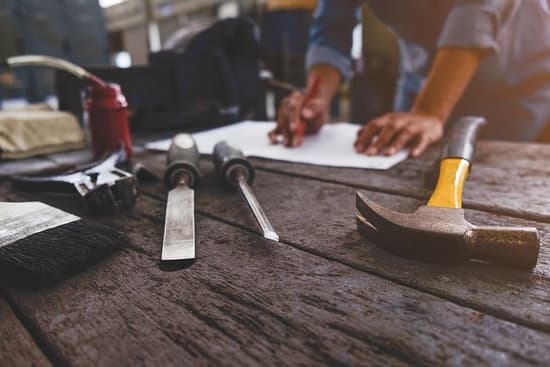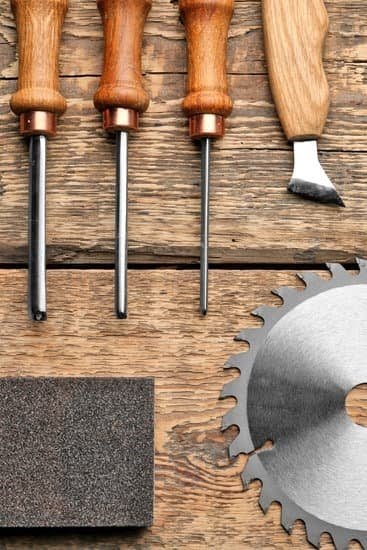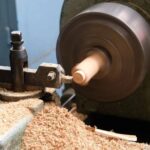Have you been asking yourself, “What shaper to get woodworking?” Choosing the right shaper is crucial for achieving precision and efficiency in your woodworking projects. From shaping edges to creating intricate designs, a good shaper can make all the difference in the quality of your work. In this article, we will delve into the world of woodworking shapers, discussing the different types available, considerations when selecting one, and recommendations for both beginners and serious enthusiasts.
When it comes to woodworking shapers, there are various types to choose from in the market. From handheld trim routers to heavy-duty stationary shapers, each type offers unique features catered to different woodworking needs. Understanding the differences between these types can help you determine which one would be most suitable for your projects.
One important consideration when selecting a shaper is whether to go with a benchtop or floor-standing model. Benchtop shapers are space-saving and portable, ideal for smaller workshops or hobbyists. On the other hand, floor-standing shapers provide more stability and power for larger-scale projects but require more space. Evaluating your workspace and project requirements can guide you in choosing between these two options.
Types of Shapers
When it comes to woodworking, choosing the right shaper is crucial for achieving precise and quality results. There are several types of shapers available in the market, each designed for specific tasks and applications. Here is a breakdown of the different types of shapers that woodworkers can choose from:
- Spindle Shapers: Spindle shapers are popular among woodworkers for their versatility and precision. They feature a vertical spindle onto which cutters can be attached, allowing for a variety of profiles to be created. These shapers are ideal for shaping edges, molding profiles, and creating intricate designs.
- Power Shapers: Power shapers are equipped with more horsepower than traditional spindle shapers, making them suitable for heavy-duty cutting tasks. They offer higher speed options, allowing woodworkers to work efficiently on large projects or harder woods.
- Tilting Spindle Shapers: Tilting spindle shapers have the ability to tilt the spindle at different angles, enabling woodworkers to create beveled edges or complex cuts with ease. This type of shaper is preferred for tasks that require angled cuts or joints.
Each type of shaper has its own set of advantages and limitations, so woodworkers should consider their specific needs and project requirements when selecting the right shaper for their workshop. Whether you are a beginner looking for a basic model or an experienced professional seeking advanced features, understanding the different types of shapers available can help you make an informed decision on what shaper to get woodworking.
It is important to note that the type of woodworking projects you undertake will play a significant role in determining what type of shaper is best suited for your needs. Consider factors such as the size of the pieces you typically work with, the complexity of cuts required, and your overall budget when evaluating which type of shaper will be most beneficial for your woodworking endeavors.
By understanding the various types of shapers available in the market, you can confidently choose a tool that aligns with your skill level and project requirements.
Benchtop vs Floor-Standing Shapers
When it comes to woodworking, choosing the right shaper is crucial for achieving precision and quality in your projects. One of the key decisions you’ll need to make is whether to opt for a benchtop shaper or a floor-standing shaper. Each type has its own set of pros and cons that can significantly impact your woodworking experience.
Benchtop Shapers
Benchtop shapers are smaller, more compact machines that are suitable for small workshops or hobbyists with limited space. These shapers are generally more affordable than their floor-standing counterparts, making them a budget-friendly option for beginners. However, the limitation in size may also restrict the capacity for larger woodworking projects. Additionally, benchtop shapers may not have as much power or stability as floor-standing models, which could affect the accuracy and quality of cuts.
Floor-Standing Shapers
On the other hand, floor-standing shapers are larger and more powerful machines designed for heavy-duty woodworking tasks. These shapers offer increased stability, precision, and power, making them ideal for professional woodworkers or enthusiasts working on larger projects. While floor-standing shapers tend to be more expensive than benchtop models, they often come equipped with additional features and capabilities that can enhance productivity and versatility in your workshop.
Power and Speed Considerations
When it comes to woodworking, power and speed are crucial factors to consider when choosing the right shaper for your projects. The amount of power a shaper possesses will determine its capability to handle different types of wood and the complexity of cuts. Higher horsepower shapers are better suited for heavy-duty tasks like shaping hardwoods or creating deep profiles, while lower horsepower models may be sufficient for lighter work.
In addition to power, the speed at which a shaper operates plays a significant role in achieving smooth and precise cuts. Shapers with variable speed settings offer more versatility as they allow you to adjust the speed based on the type of cut or material you are working with. Slower speeds are ideal for making intricate designs or cutting denser woods, while higher speeds can streamline larger projects that require quick material removal.
Another important consideration when looking at power and speed in a shaper is the efficiency and accuracy of your cuts. A well-balanced combination of power and speed will result in cleaner cuts, reduced vibrations, and overall better performance.
It’s essential to match the power and speed capabilities of a shaper with the demands of your woodworking projects to achieve optimal results. By carefully evaluating these factors, you can ensure that you select a shaper that meets your needs and enhances your woodworking experience.
Choosing the Right Power Output
The power output of a shaper is typically measured in horsepower (HP), with higher HP ratings indicating more strength for handling tougher materials or demanding tasks. Consider the types of wood you work with most frequently and the level of intricacy in your designs when determining how much power you need in a shaper.
Adjustable Speed Settings
Having adjustable speed settings on a shaper provides greater flexibility in controlling the cutting process. Different types of cuts may require varying speeds to achieve optimal results, so having this feature allows you to adapt to different woodworking challenges effectively.
Cutter and Spindle Options
When it comes to woodworking, selecting the right cutter and spindle options for your shaper is crucial in achieving the desired results. Understanding the different types of cutters and spindles available can help you choose the most suitable tools for various woodworking tasks. One important factor to consider is the type of material you will be working with, as this will influence the type of cutter and spindle needed for optimal performance.
For example, when working with softer woods like pine or cedar, a high-speed steel cutter may be sufficient for clean cuts. On the other hand, hardwoods like oak or maple may require carbide-tipped cutters for better durability and precision.
Similarly, different spindle sizes can accommodate various cutter types, allowing for flexibility in shaping profiles and creating unique designs in your woodwork projects. It is essential to match the right cutter and spindle combination to achieve the desired results while ensuring safety in operation.
Additionally, considering the complexity of your woodworking tasks can also guide your decision-making process when choosing cutter and spindle options for your shaper. For intricate designs that require detailed profiles or grooves, specialized cutters with multiple blades or custom profiles may be necessary.
Adjustable spindles that allow for varying speeds can also enhance versatility in shaping different wood materials effectively. By evaluating the specific requirements of your woodworking projects, you can select appropriate cutter and spindle options that will optimize performance and deliver professional-quality results.
Safety Features
When it comes to woodworking, safety should always be a top priority. This is especially true when using power tools such as shapers, which can pose significant risks if not operated properly. Safety features in a shaper are essential to protect the user from potential accidents and injuries. Here are some key safety features to look for when choosing a shaper for your woodworking projects:
- Emergency Stop Button: An emergency stop button is a crucial safety feature that allows you to quickly shut off the machine in case of an emergency or if something goes wrong during operation.
- Protection Guards: Look for a shaper that comes with sturdy protection guards that help prevent accidental contact with the cutter or spindle while the machine is in use.
- Featherboards and Hold-Downs: These accessories help keep the workpiece securely in place and against the fence or table during cutting, reducing the risk of kickback and ensuring smoother cuts.
In addition to these specific safety features, it’s also important to consider the overall build quality and design of the shaper. Choose a model that is well-made, durable, and built to withstand heavy use. It’s also a good idea to invest in proper safety gear such as goggles, hearing protection, and dust masks when operating a shaper.
Remember, no matter what shaper you decide to get for your woodworking projects, always prioritize safety above all else. By choosing a shaper with robust safety features and following best practices for safe operation, you can enjoy your woodworking hobby or profession without compromising on your well-being. What Shaper to Get Woodworking is ultimately one that prioritizes safety without sacrificing performance.
Budget-Friendly Options
One popular budget-friendly option for woodworking enthusiasts is the benchtop shaper. Benchtop shapers are smaller in size compared to floor-standing models, making them ideal for compact workspaces or entry-level woodworkers. Despite their smaller stature, benchtop shapers can still pack a punch when it comes to performance and versatility. They offer a good balance between affordability and functionality, making them suitable for those who are just starting out in woodworking.
Another budget-friendly consideration when deciding what shaper to get for woodworking is opting for a basic model with essential features. While advanced shapers may come with bells and whistles that enhance efficiency, basic models can still deliver reliable results without costing an arm and a leg. It’s crucial to prioritize key features such as power output, spindle speed, and adjustability while staying within your budget constraints to make the most of your woodworking projects.
| Features | Importance |
|---|---|
| Price Point | Crucial factor for beginners or hobbyists on a budget |
| Benchtop Shaper | Compact size suitable for small workspaces and entry-level woodworkers |
| Basic Model | Prioritize essential features like power output and adjustability while sticking to your budget |
Professional-Grade Shapers
One of the key features to look for in a professional-grade shaper is a robust motor with ample power to handle challenging materials and cutting tasks. High horsepower motors provide the necessary strength to cut through hardwoods, softwoods, and even composite materials with precision and efficiency. Additionally, variable speed control is another important factor to consider as it allows woodworkers to adjust the cutting speed according to the requirements of the material being worked on.
In addition to motor power and speed control, professional-grade shapers should offer a wide range of cutter and spindle options to accommodate various woodworking tasks. These versatile tools allow woodworkers to create intricate designs, profiles, and joinery with precision and accuracy.
Taller fences, adjustable tables, and easy-to-use controls are also desirable features that enhance the functionality of professional-grade shapers. Investing in a high-quality shaper ensures that woodworking enthusiasts can achieve superior results in their projects while enjoying long-lasting performance from their equipment.
| Features | Importance |
|---|---|
| Robust Motor | Provides strength for cutting tasks |
| Variable Speed Control | Allows adjustment based on material requirements |
| Versatile Cutter and Spindle Options | Accommodates various woodworking tasks |
Conclusion
In conclusion, selecting the right shaper for woodworking projects is crucial to achieving the desired results with efficiency and precision. With various types of shapers available in the market, including benchtop and floor-standing options, woodworkers must consider the pros and cons of each to suit their specific needs. Understanding how power and speed affect performance, as well as exploring different cutter and spindle options, can help individuals make an informed decision when choosing a shaper.
Moreover, safety features should never be overlooked when deciding what shaper to get for woodworking purposes. It is essential to prioritize machines that come equipped with safety measures to prevent accidents and ensure a secure working environment. For those starting out or pursuing woodworking as a hobby, budget-friendly options are available that still offer quality performance. On the other hand, serious woodworking enthusiasts may want to invest in professional-grade shapers for superior results and durability.
When considering what shaper to get for your woodworking projects, it is essential to weigh all factors carefully – from type and power to safety features and budget considerations. By taking the time to research and understand your specific requirements, you can choose a shaper that meets your needs effectively while enhancing the quality of your craftsmanship. Remember that investing in the right tool can ultimately make a significant difference in the outcome of your woodworking projects.
Frequently Asked Questions
What Should I Look for in a Wood Shaper?
When looking for a wood shaper, it is important to consider the horsepower of the motor, the speed options available, and the size of the cutter heads that it can accommodate. Additionally, look for features like adjustable fences, dust collection capabilities, and ease of use to ensure that the wood shaper meets your specific woodworking needs.
Do I Need a Wood Shaper?
Whether or not you need a wood shaper depends on your woodworking projects and level of expertise. If you frequently work on projects that require intricate shaping or profiling of wood pieces, investing in a wood shaper can be beneficial. However, if your projects are more basic or hobby-oriented, other tools like routers may suffice.
What Is a Shaper Used for in Woodworking?
A shaper is commonly used in woodworking to shape and profile wood pieces with precision and efficiency. It allows woodworkers to create decorative edges, moldings, raised panels, joinery components, and other custom profiles on wooden pieces. The versatility and power of a shaper make it an essential tool for professional woodworkers who require accurate shaping capabilities in their projects.

Hi everyone! I’m a woodworker and blogger, and this is my woodworking blog. In my blog, I share tips and tricks for woodworkers of all skill levels, as well as project ideas that you can try yourself.





